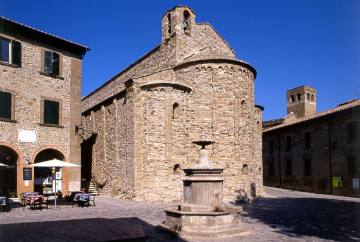|
Strictly speaking it's no longer part of the Marche, having voted, along with six other towns, to become part of neighbouring Romagna. But we couldn't
leave out such a splendid place just over the border.
Seen in profile from the distance, rising out of the craggy landscape, the castle-topped rock of San Leo looks for all the world like a miniature version
of the nearby Republic of San Marino.

There are, indeed, many parallels between the two fortresses, though San Leo has thankfully worn the ravages of tourism rather more gracefully than her
bigger republican sister.
Today's approach road is certainly safer than the rocky ledge that earlier travellers had to negotiate to reach
the main gate, but the town still retains the isolated air of one of the furthest outposts of the Papal States.
It was to this fortress that many a papal prisoner was brought to pass the remainder of their days in quiet oblivion.
San Leo was an ecclesiastical stronghold as early the 8th century. In the town below the fortress, the ninth
century parish church, built in the form of a basilica, stands in front of the larger twelfth century cathedral, each of which contain notable examples of early
sculpture, including columns dating back to the Roman period.
It is a short, sharp hike up from the town to the vast fortress above, which looks out across the wild countryside of the northern Marche.
Parts of it this rocca are of Roman origin but the two vast circular keeps which frame its western flanks are the work of Francesco di Giorgio Martini, one of Italy's finest renaissance military architects, who was much used by Duke Federico of Montefeltro.
By the 18th century San Leo's chief claim to fame was as the papal top security prison. Most famous of all its
inmates was Giuseppe Balsamo, better known as Count Cagliostro, alchemist, fortune-teller, miracle worker, freemason and the man who managed to persuade a large band of aristocratic followers that he had found
the secret of eternal life. Unfortunately for him, he was arrested and convicted of heresy by the Holy Inquisition and died here in 1795. Though some claim he is still with us...
|